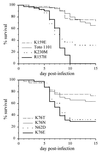Large-plaque mutants of Sindbis virus show reduced binding to heparan sulfate, heightened viremia, and slower clearance from the circulation
- PMID: 10623725
- PMCID: PMC111583
- DOI: 10.1128/jvi.74.2.644-651.2000
Large-plaque mutants of Sindbis virus show reduced binding to heparan sulfate, heightened viremia, and slower clearance from the circulation
Abstract
Laboratory strains of Sindbis virus must bind to the negatively charged glycosaminoglycan heparan sulfate in order to efficiently infect cultured cells. During infection of mice, however, we have frequently observed the development of large-plaque viral mutants with a reduced ability to bind to heparan sulfate. Sequencing of these mutants revealed changes of positively charged amino acids in putative heparin-binding domains of the E2 glycoprotein. Recombinant viruses were constructed with these changes as single amino acid substitutions in a strain Toto 1101 background. All exhibited decreased binding to heparan sulfate and had larger plaques than Toto 1101. When injected subcutaneously into neonatal mice, large-plaque viruses produced higher-titer viremia and often caused higher mortality. Because circulating heparin-binding proteins are known to be rapidly sequestered by tissue heparan sulfate, we measured the kinetics of viral clearance following intravenous injection. Much of the parental small-plaque Toto 1101 strain of Sindbis virus was cleared from the circulation by the liver within minutes, in contrast to recombinant large-plaque viruses, which had longer circulating half-lives. These findings indicate that a decreased ability to bind to heparan sulfate allows more efficient viral production in vivo, which may in turn lead to increased mortality. Because Sindbis virus is only one of a growing number of viruses from many families which have been shown to bind to heparan sulfate, these results may be generally applicable to the pathogenesis of such viruses.
Figures





References
-
- Abrahamson S L, Wu H-M, Williams R E, Der K, Ottah N, Little R, Gazzano-Santoro H, Theofan G, Bauer R, Leigh S, Orme A, Horwitz A H, Carroll S F, Dedrick R L. Biochemical characterization of recombinant fusions of lipopolysaccharide binding protein and bactericidal/permeability-increasing protein. J Biol Chem. 1997;272:2149–2155. - PubMed
-
- Bauer R J, Der K, Ottah-Ihejeto N, Barrientos J, Kung A H C. The role of liver and kidney on the pharmacokinetics of a recombinant amino terminal fragment of bactericidal/permeability-increasing protein in rats. Pharm Res. 1997;14:224–229. - PubMed
-
- Bhattacharyya D, Brooks B R, Callahan L. Positioning of positively charged residues in the V3 loop correlates with HIV type 1 syncytium-inducing phenotype. AIDS Res Hum Retrovir. 1996;12:83–90. - PubMed
-
- Cahan L D, Singh R, Paulson J C. Sialyloligosaccharide receptors of binding variants of polyoma virus. Virology. 1983;130:281–289. - PubMed
Publication types
MeSH terms
Substances
Grants and funding
LinkOut - more resources
Full Text Sources
Other Literature Sources

